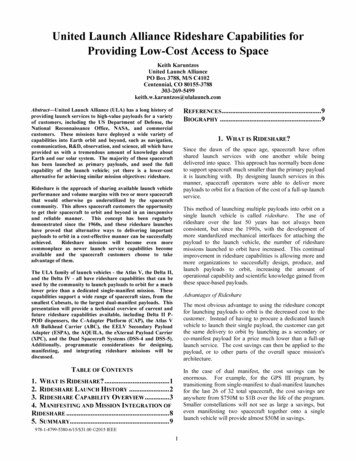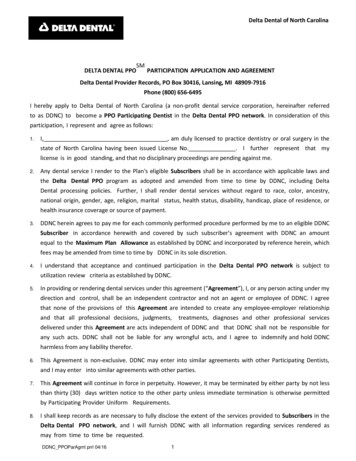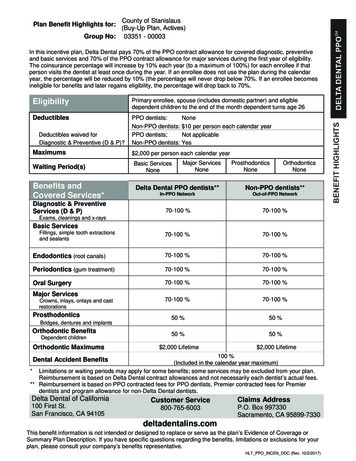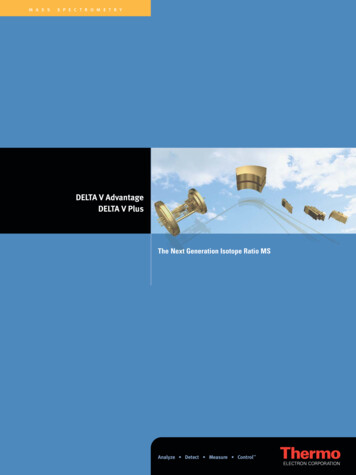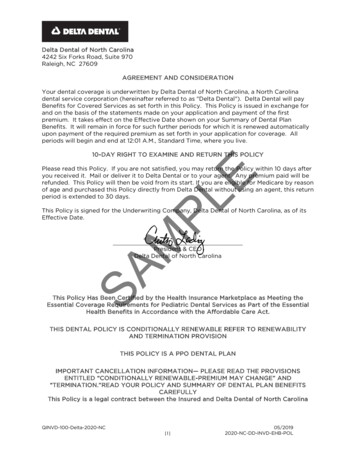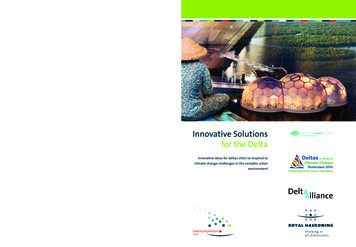
Transcription
Rotterdam image courtesy of Marc HeemanInnovative Solutionsfor the DeltaThe DeltaCompetition is an international competition for students to come up with scientifically underpinned, innovativeand sustainable solutions for the inhabitants of vulnerable delta areas. Organised in 2006 and 2008 by Royal Haskoning theDeltaCompetition attracted a range of innovative solution for delta areas. This year Royal Haskoning partnered with Delta Allianceand the city of Rotterdam to challenge students worldwide to come up with solutions for urbanized deltas subjected to complexchallenges of climate change.Innovative Solutions for the Delta The DeltaCompetition 2010It is often the vast fertile deltas, such as those of the Rhine, Mekong and Mississippi, which are densely populated regions withhighly developed economies. The people who live there are becoming increasingly aware of the urgency of taking appropriatemeasures to counteract the disastrous effects of climate change and the associated rise in sea levels. This book presents theten best entries in the DeltaCompetition 2010. Each and every one of them is an innovative report that contains the promise ofsustainable solutions to the challenges that changing climatic conditions are confronting us with.Innovative ideas for deltas cities to respond toclimate change challenges in the complex urbanenvironmentPublished by Royal Haskoning,P.O. Box 151, 6500 AD Nijmegen,Barbarossastraat 35, 6522 DK Nijmegen,The NetherlandsDeltaCompetition2010
Innovative Solutions for the DeltaInnovative ideas for deltas cities to respond toclimate change challenges in the complex urban environmentDeltaCompetition2010
InnovativeSolutionsfor the Delta4
contentsForeword6Report of the Panel of Judges7-8Panel of judges CVs9 - 11WINNERSEcology as Industry13 - 28Groundwater Zoning as Spatial Planning in Semarang29 - 37The Big Leak39 - 49RUNNERS UPNymphaea51 - 57A Working Landscape for New Orleans59 - 71DeDamming Urbanism73 - 86Transformative Shit87 - 95Surviving Delta City97 - 105Baltimore Water Works107 - 115Institutional Design Principles for Climate Change Adaption117 - 131InnovativeSolutionsfor the Delta5
ForewordDeltaCompetition 2010: Innovative ideas for deltas cities to respond toclimate change challenges in the complex urban environmentDear reader,Half of the world’s population lives in densely populated city regions in delta areas. These delta cities are amongthe most dynamic areas in the world. But delta cities are also highly vulnerable to the impacts of climate change.Rising sea levels, increased river discharge, extreme weather conditions, salination of groundwater and subsidenceconstitute significant and increasing threats to the delta cities and the people living in them.The increased pressure on delta cities has led policy makers and experts to rethink their development strategies.Countries all over the world are looking into ways to adapt to climate change. All over the world, people are trying tofind practical, innovative, sustainable solutions to adapt to the impacts of climate change and facilitate sustainabledevelopment of delta cities.Since 2006, the DeltaCompetition has sought new, creative and innovative solutions to these challenges andreceived many original, feasible and scientifically sound ideas for pioneering projects. In 2010 we have involvednew partners who share our vision in this regard. They are Delta Alliance, an emerging worldwide network devotedto the problems of deltas, and the Municipality of Rotterdam, a delta city that has already made significant stepstowards a sustainable, climate proof development.This year there were more entries than ever. In total no fewer than 24 teams from all over the world sent in theirideas. We were pleasantly surprised by their high quality. The broad scope of the proposals was also remarkable. Inaddition to ‘classic’ engineering solutions, this year we received many entries with a landscape or managerial slant.Take the entry by a team from America’s Harvard University. Their project explored the disadvantages of climatechange in the Netherlands and sought to turn them around. The result was a far-reaching, long-term vision withecology as the keynote, which could not fail to stimulate and challenge.An entry by Novi Rahmawati, of Indonesia’s Gadjah Mada University, examined the consequences of urban landsubsidence, probably the greatest challenge in that region. Based on a thorough model-based study, she presenteda readily applicable solution.Virginia University’s David Wooden also contributed plans to cope with the consequences of subsidence. However,his entry offers a different innovative solution, tailored to the local situation in New Orleans. A feature of his entryis its integral design.The ten best papers of the 2010 DeltaCompetition have been incorporated in this book. We hope they will inspireyou, like Royal Haskoning, the Delta Alliance and the City of Rotterdam, to respond creatively and sustainably to thechallenges facing the world’s delta regions.Jan Bout,Chairman of the Board of ManagementInnovativeSolutionsfor the Delta6Royal Haskoning
Report of the Panel of JudgesThe judges of the 2010 DeltaCompetition received and reviewed a total of 24 papers submitted by students fromall over the world with great pleasure and interest. As set out in the DeltaCompetition rules, entries were appraisedby the judges with particular attention to: relevance to a problem that delta cities face with climate change; innovative elements and ideas; and scientific fact and reasoning;presentation of concepts and ideas.In general, the judges were impressed with the range of subjects and the innovativeness of the papers. The highquality of submissions made the selection of winning papers a difficult task, but the judges finally reached a verdictwith three winning papers and seven runners-up. The ten chosen papers are presented in this volume, togetherwith comments from the judges on the three winning papers.The following papers have been selected as the three winners:Ecology as industryHaein Lee, Gyoung Tak Park, and Soomin Shin, Harvard University, Landscape ArchitectureThis vision for de-engineering water management in The Netherlands presents a regional plan for capitalizingupon the local ecology while addressing increasing flood hazards and land subsidence. Four transformationsfor the Dutch delta are outlined: coastal, infrastructure, estuarine and urban. These transformations includemulti-use de-poldered areas, constructing barrier islands, relocating port activity, new industries of aquacultureand alternative energy production and an expansive recreational landscape. Through thickening flood-defenceand allowing sedimentation and peat growth to match rising sea levels, the transformations promise toimprove safety while simultaneously restoring diverse habitats.This increasingly popular concept of harnessing natural processes in designing flood defence is elegantlypresented in this paper. Specific measures are incorporated into a strong overall vision, which is supportedwith substantial background on the Rhine-Meuse delta and striking images. It powerfully illustrates that theissues facing delta cities require regional approaches that view the delta as a landscape system.InnovativeSolutionsfor the Delta7
Groundwater zoning as spatial planning in SemarangNovi Rahmawati, Gadjah Mada University, Water Resource ManagementThe Semarang delta, like many of the world’s deltas, is encountering increasing flooding problems due to landsubsidence. In parts of the delta land subsidence due to groundwater exploitation and construction loadsexceeds 16 cm per year. Intensive groundwater abstraction in the coastal areas of Semarang is addressed in thispaper through the idea of groundwater zoning – spatial planning based on identifying the areas most degradedand at risk of degradation through groundwater abstraction. Novi Rahmawati modeled the groundwater flowin North and East Semarang sub watersheds to delineate appropriate zones for groundwater recharge anddischarge.The paper shows clear insight into the local situation by addressing the greatest threat of Semarang. Thejudges consider the proposed solution a practical proposal for confronting subsidence, which is also highlyrelevant for many deltas around the world. Jurors also noted that the modeling of the groundwater flow waswell supported with detailed dataThe Big Leak: Adaptive responses to New Orleans’ land subsidence crisisDavid Wooden, Virginia University, Landscape ArchitectureThe land subsidence crisis of New Orleans is tackled with the proposal of an adaptable stormwater conveyancesystem that intentionally “leaks” to maintain water tables in the city. Low water tables speed up the processof subsidence, and water that would otherwise be replenishing the water table is currently being diverted bythe stormwater system. Replacement of this system with parametrically derived surface canals would act asan ex-filtrating infrastructure for strategically recharging the water table, stopping or reducing the rate of landsubsidence.An intelligently crafted concept for combating subsidence, this paper beautifully presents an integratedand very applicable solution for a sinking city. Judges were impressed by the innovative idea and excellentpresentation of this paper.InnovativeSolutionsfor the Delta8
Panel of Judges CVsInnovativeSolutionsfor the Delta9
Prof. Dr. Sybe Schaap (Chair)Professor Waterpolicy and governance at Delft University of TechnologyVU University of Amsterdam, Lecturer in PhilosophyFormer Chairman of the Union of Water Boards of the NetherlandsSybe Schaap has an agricultural background and an education in economics, social sciences and philosophy. Dr.Schaap wrote several publications on philosophical, organizational and agricultural topics. He is involved as aLecturer in Philosophy at the VU University of Amsterdam and the Charles University in Prague.Sybe Schaap is actively involved in water management issues in the Netherlands. During his six years as Chairmanof the Union of Water Boards, Sybe Schaap modernized the board’s financial structure. As Chairman of the WaterBoards, he focused on the importance of safe dikes and the impact on society. He also expressed this importancein an international context and put this on the international water agenda. He gave several presentations oninternational missions and was a presenter at the last World Water Forum. Sybe Schaap was an advocate of thesecond Delta Committee of the Netherlands, long before it was established.Alongside his involvement in the Dutch and international water world, Sybe Schaap is actively involved in politics.He is also a member of the Dutch Senate and was awarded the royal title ‘Officer of the Order of Oranje-Nassau’for his work in 2009.Prof. Dr. Hans OpschoorVU University of Amsterdam, Professor in Environmental EconomicsInstitute of Social Studies, Professor of Sustainable Development EconomicsHans Opschoor is Professor of Sustainable Development Economics at the Institute of Social Studies and Professorin Environmental Economics at the Free University of Amsterdam. Hans Opschoor has worked in the field ofenvironmental and ecological economics since 1971. Since 1978, he has specialized in international aspects of thesefields, especially north-south ones. He has worked and lived in Southern Africa (Botswana) and been involved inprojects in India and China. Recently, Hans Opschoor has focused on the economics of climate change as wellas environment and poverty. In addition to that, he has a strong interest in scientific/academic co-operation inresearch and capacity development in the North-South nexus. Hans Opschoor has published 13 edited volumesand monographs and more than 170 articles, mostly on environment and development, environmental economics,environmental policy, and environmental policy instruments.InnovativeSolutionsfor the Delta10
Prof. Dr. Pier VellingaWageningen University, Director of the Knowledge for Climate Program in the NetherlandsPier Vellinga is Professor in Environmental Sciences and Climate Change at Wageningen University Research andVrije Universiteit Amsterdam. Originally he specialized in coastal engineering contributing to the Delta plan of theNetherlands and currently Pier Vellinga is one of the Netherlands’ experts on the impacts of climate change. Inaddition to being Chairman of the Knowledge for Climate Research Program, Dr. Vellinga is Vice Chairman of theClimate Changes Spatial Planning Program. In 2009, he initiated the international Delta Alliance, a collaborationamong low lying coastal areas in the world vulnerable to climate change. Pier Vellinga is a Board Member of severalresearch institutes and environmental organizations in the Netherlands and abroad.Mr. Tom Smit, LLM, MScDirector of Royal Haskoning’s Spatial Development DivisionOrganization of the Delta Competition in 2006 and 2008Tom Smit is a Senior Management Consultant with law degrees from Leiden and Harvard Universities and hasextensive experience in the public and private sector. He has advised numerous governments in the Netherlandsand abroad on transport, infrastructure, utilities, water, environmental and spatial planning legislation andadministration.During his career at the Ministry of Spatial Planning and the Environment, Tom Smit was responsible for the draftingand implementation of the Dutch Environment Law. In his capacity as Director of the Union of Water Boards, afterserving as Director of the Limburg Water Board, he was involved in the drafting and implementation of the Law onthe Water Boards. After that, he joined Twynstra Gudde management consultants, ultimately serving as ManagingPartner at this firm. In 1998, he joined Royal Haskoning, first as Director of the Environment and Water Divisions, andcurrently managing the Spatial Development Division.At Royal Haskoning, Tom Smit has been involved in the regional consultation process leading towards theformulation of the new National Water Plan and an international comparative analysis of (integrated) waterlegislation. Alongside various evaluation studies and consulting assignments in the Netherlands, in recent yearshe has also provided advice on the water and environmental management capacity of governments in countriessuch as Romania, Bosnia-Herzegovina and Greece and was involved in various Environmental Impact Assessmentprojects, such as the extension of the Maasvlakte in the Rotterdam Harbor.InnovativeSolutionsfor the Delta11
InnovativeSolutionsfor the Delta12
Surviving Delta CityResponse to Global Warming (Case: Semarang City, Center of Java, Indonesia)Runner UpFitria Nuraini SekarsihAttin Krisna HaksariAri CahyonoRayendra AnandikaGadjah Mada University, IndonesiaInnovativeSolutionsfor the Delta97
AbstractSemarang is one of the largest cities in Indonesia, which suffered the greatest threat from the impacts ofsea level rise. Since the beginning, Semarang has been a city that has been facing many problems, especiallydisaster, such as flash floods, tidal floods (rob), seawater intrusion, land subsidence, shoreline retreat, etc.The sea level rise issue hots up when the predicted number of important locations in Semarang could beinundated. It needs a strategy of adaptation to include the manufacture of DA, the concept of the waterfrontcity to Semarang’s harbor, cooperation with insurance companies, and society. Integration between thecommunity, the government, and private adaptation is needed in addressing the rise in sea levelBACKGROUNDClimate change is presented as a causal chain of consequences starting from greenhouse gas emissions that alterthe atmosphere’s radiative balance, changing climate and leading to impacts that range from the biophysicalthrough to the socio-economic (Jones et al, 2007).One of the climate change impacts is the melting of polar ice that will cause the sea level to rise. The mostvulnerable area affected by the sea level rise is the coastal area.The big cities in Indonesia, mostly located along the coast are Jakarta, Semarang, Surabaya, Medan, Makasar and soon. Those cities grew around the delta because the merging of the mainland and rivers and the sea form their ownecosystem that is unique and people are interested in living there.A delta’s area may be defined as 1) the seaward prograding and area that has accumulated since 6,000 years,when the global sea level stabilized within a few meters of the present level (Amorosi and Miller 2001 in Syvitski,2008), 2) the seaward area of a river valley after the main stem of a river splits into distributary channels (Syvitskiand Saito 2007 in Syvitski, 2008), 3) the area of a river valley underlain by Holocene marine sediments (Kubo et al.2006 in Syvitski, 2008), 4) accumulated river sediment that has variably been subjected to fluvial, wave, and tidalinfluences (Overeem et al. 2005 in Syvitski, 2008), 5) the area drained by river distributary channels that are underthe influence of tides (Syvitski, 2008)Semarang City is one of the worst delta cities in the world. The city of Semarang is the capital city of the CentralJava Province, located on the North Road crossing points linking the island of the Java city of Surabaya and Jakarta.Geographically, located between 109o 35 ‘- 110o 50’ east longitude and 6O 50’- 7o 10’ south latitude. With 373.70km2 area, the city of Semarang haslimited its administrative regions asfollows: in the north the Java Sea, in thesouth the Semarang District, in the eastthe Demak District and the GroboganDistrict, and in the west the KendalDistrict.Figure 1 Semarang coastal areaInnovativeSolutionsfor the Delta98
SOCIO-ECONOMIC DEVELOPMENTNow, more than 50% of the entire world population lives in cities.The priority development area of Semarang city is divided into four regions and the development of each region isdivided in several parts of the city, and each section has a scale with urban development priorities. Developmentpriorities include: trade, offices, services, education, sports, transportation, industrial, residential, agricultural, andthe development of the New Town in the sub-district of Mijen.Semarang city is becoming increasingly crowded and the support capacity of diminishing land should have nothappened by setting up additional development centers of industry, trade settlement and so on. The physicalcondition of the land has exceeded the threshold of its capability, so many problems and disasters often occur inthe city of Semarang.The government should focus more on regional arrangements and perform controls so that the physical conditionof the land and industry and the impact of human activity on the environment can be minimized.It is ironic indeed when the government had to choose between the economy and the environment. Developingcountries cannot synchronize between the high economic income with environmental sustainability. Somethingmust be sacrificed. When the government of Semarang intends to develop areas of industry for economic purposesand increase revenue, then what happens is damage to land and the impact of the deteriorating environment. Theremust be a consequence of the various stakeholders to solve the environmental impacts due to prolific industry inSemarang City.MULTI-HAZARD ASSESSMENTA delta’s low gradient is both attractive and dangerous for human use. A large flat delta is attractive because it hasthe potential for easy agricultural development, made further attractive by its rich organic soil. Deltaic sedimentsare at the finer-grained end of a river’s flood plain and are generally rich in important organic carbon; populationcenters are often located on deltas. It is predicted that they will increase rapidly.According to the United Nations, more than two-thirds of the world’s large cities are vulnerable to rising sea levels,exposing millions of people to the risk of extreme floods and storms. Within the next 30 years, the United Nationspredicts that the number of people living in cities will increase to 60% of the world’s population (Aerts et al, 2009)Coastal regions have a complex geomorphologic process and a physical process. The physical processes are waves,tidal inundations, erosion, sedimentation, sea level rise, etc. In the case of Semarang, coastal floods driven by hightidal floods, low lying areas, flash floods, and land subsidence occur at many sites.SubsidenceSemarang is a capital city in Central Java Province. The city is a center of economic activities, housing, industry, etc.Extensive land use change and industrialization increase the groundwater extraction leading to land subsidence.Whereas subsidence increases a delta’s vulnerability, the impact is made much worse by anthropogenic control onthe supply and routing of sediment to and across a delta. The land subsidence caused by withdrawal of groundwaterfor industry and household.The rate of the subsidence can be generated by benchmarking. From the benchmark data, it can be seen that therate of subsidence in Semarang varies from 2 to 10 cm/year and the maximum rate is about 16 cm/year (Marfai andKing, 2007).InnovativeSolutionsfor the Delta99
People living in the coastal area of Semarang have been experiencing the threat of coastal inundation almostconstantly. Assuming a zero-growth rate of the population in future years, it is estimated that 148,000 peoplewould be suffering from inundation (Marfai and King, 2007a).These areas have a high-population density and are a center of industrial development and therefore, thevulnerability is very high. With the assumption that in the future years the land use pattern remains the same asthe current situation, the total potential economic loss due to the coastal inundation under enhanced sea levelrise in the capital city of Central Java Province is expected to be about 11,812.8 million for 120 cm of inundation and12,330.8 million for 180 cm of inundation (Marfai and King 2007b)Table 1 The prediction of future land subsidence in Semarang (in ha)YearElevation below sea level 8.027.52227.0Source: Marfai and King (2007)FloodIn the Semarang region, land subsidence plays an important role for the extended inundation in the coastal area.The other sources of inundation are flash floods and rob. Semarang consists of a hilly area in the southern partand low land area in the northern part. So rain water will quickly come towards the sea. Land use cover change isvery intensive, from vegetation to settlement area also cause floods every year which happens to be getting worse.Furthermore, under the scenario of sea level rise and land subsidence, coastal inundation would be even worse.Shoreline ChangeSea level rise is one of the results of global warming. It has a direct impact on the increasing inundation in thecoastal area. Semarang is clearly a city that annually suffered from flash floods and tidal floods. It will get worse ifthe sea level risess.The most serious physical impacts ofsea level rise are (1) coastal erosion,(2) inundation and displacement ofwetlands and lowlands, (3) increasedcoastal storm flooding and damage,and (4) increased salinity of estuariesand aquifers (Barth and Titus 1984 inMarfai and King 2007b).Semarangannuallysuffersfromflash floods and tidal floods. This iscausing large scale inundation in manybuildings, public facilities including therectangle will be simulated in the iteration modelcapacity of the river, canal, or drainageand tidal flood/Rob (Marfai and King, 2007c). Inundated area in redInnovativeSolutionsfor the Delta100important sites like roads, residentialFigure 2 The Semarang Topographic. vulnerable city from flash floodairport in 2007. The flood caused by the
systemdidn’tenough.Over capacity of floodbecause of deforestationin the upper basin, culturaltraditions which regardrivers as waste disposal,high sedimentation, andtidal flood which comecoincidently.Figure 3 Inundation map of Semarang using different scenarios. (a) 0.25 meter scenario,(b) 0.50 meter scenario, (c) 0.75 meter scenario, (d) 1.00 meter scenario, (e) 1.25 meterscenario, (f) 1.50 meter scenario. Source: Data Processing 2010The warm case relatedto sea level rise issue island subsidence. Landsubsidence together withthe sea level rise cause the city to sink at a rate of t 3.8 /year (Aerts et al, 2009) mainly due to groundwater extraction.Shoreline position would change the different rate of sediment supply, accretion or erosion process. River deltasare coastal features developed from the accumulation of sediment near the mouths of rivers (Syvitski, 2008). Butin Semarang, the delta can’t be seen clearly. The main factor is because the dominant process in coastal dynamicis shoreline retreat.Figure 4 and Figure 5 show that the shoreline change in Semarang is happening very intensively. The temporaryLandsat images are used for extracting the shoreline at the same date in different years. The data sources areshoreline in 1972, shoreline in 1982, shoreline in 1992, and shoreline in 2002. The next step is to calculate theshoreline change by using DSAS extension software in ArcView. If the JKR have a negative value, this means that theshoreline has been retreating. But if the JKR have a positive value, the sedimentation was dominant in this shore.Figure 4 Shoreline change in Semarang at differentFigure 5 Shoreline retreat inProcessing 2010Sources: Data Processing 2010times. JKR means shoreline change. Sources: DataSemarang at different times.InnovativeSolutionsfor the Delta101
ADAPTATIONClimate change is directly affecting the living conditions of most of the people in developing countries, throughincreasing variability and uncertainty of the conditions in which people try to pursue their livelihoods (Cannon andMüller, 2010).Adaptation is the adjustment in natural or human systems in response to the actual or expected climatic stimuli ortheir effects, which causes harm or exploits beneficial opportunities (Cannon and Müller-Mahn, 2010). Adaptationis defined as adjustments in practices, processes, or structures in response to projected or actual changes in climate(Dixon et al, 2003). Adaptation also influences different parts of the projected range of mean global warming at anygiven time in the future (Jones et al, 2007).A global estimation of the cost adaptation to climate change is likely to be below 0.1% of the Gross DomesticProduct (The Stern Review in Aerts et al, 2009).Adaptation to climate change is not simply a response to meteorological parameters, but it is primarily driven bydiscourses about these phenomena in a society (Cannon and Müller, 2010).Investing in adaptation would save money in the future (Aerts et al, 2009). The sea level rise will influence thevulnerability in the future. The government, scientists, and society have an important role to prepare the adaptationand assess the risk.Society, scientists, and policy makers have to consider the climate change issue of adaptation and embed long-termscenario in planning.Some adaptations can reduce negative impacts or take advantage of new opportunities presented by changingclimate conditions (Dixon et al, 2003) adaptation also increases the ability to cope incrementally or produce oneor more step changes (Jones et al, 2007). The adaptation strategy must consider the local characteristic of thearea including the hazard, resources, institution, etc. This is some of the adaptation that can be implemented inSemarang city based on their characteristic.Mega DAM constructionInfrastructures have been prepared for global warming threatening. Protection strategy can be implemented byconstructing hard structures, e.g., seawalls, dykes and breakwaters as well as using by soft measures, e.g., beachnourishment (Marfai and King 2007c)As mentioned above, Semarang isannually threatened by tidal floods. ItProposed DAMwill get worse in the rainy season whenflash floods and tidal floods come atthe same time. So, one of the solutionsthat can be implemented is the MegaDAM construction to protect Semarangcity. Figure 7 shows the vertical sectionof the concept.The advantages of the constructionare 1) the city is out of danger from theflash flood because the water comingfrom the hilly area will be pumped outInnovativeSolutionsfor the Delta102Figure 6 The DAM connected A-B. A-B is the most important road inIndonesiato the deep sea, 2) the city is safe from
Windmill forpumping the waterDeep WaterShallow WaterLandFigure 7 The upper part of DAM can be used as a national road for connecting the two citiesthe tidal flood, 3) the upper part of the DAM can be a national road that can connect Kendal and Demak, 4) soilconservation because the shoreline retreat intensively happens in Semarang.Water front cities conceptSemarang has the largest harbor in Indonesia, Tanjung Mas. Because of the DAM construction, the harbor site mustbe rearranged and the city must be constructed more sustainably. This requires a high level of technology and thescience of developing a city without causing damage.In Semarang, the future population is predicted to increase; one of the factors is industrialization which causedurbanization. Finding properties for living and far from a vulnerable area is very difficult. One of the solutions isintegrated between adaptation for sea level rise and comfortable quality for living, i.e. waterfront cities.There are many cities in the world that have been applying the waterfront city concept for example in Dubai andthe Netherlands. This concept can be implemented in Indonesia as an archipelagic island.Insurance sector.Climate change is not only a threat for insurers but also provides new business opportunities. The experience of theinsurance sector with assessing, managing, and spreading risk may be useful in fostering adaptation of societies
A Working Landscape for New Orleans 59 - 71 DeDamming Urbanism 73 - 86 Transformative Shit 87 - 95 Surviving Delta City 97 - 105 Baltimore Water Works 107 - 115 Institutional Design Principles for Climate Change Adaption 117 - 131 contents. 6 Innovative Solutions for the Delta Foreword DeltaCompetition 2010: Innovative ideas for deltas cities to respond to climate change challenges in the .



